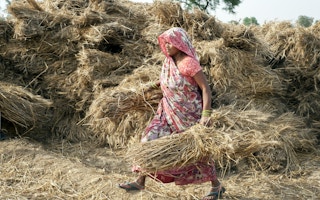The floods that have devastated the state of Tamil Nadu are a stark reminder that while India’s priority is development, it also needs to spend prodigious sums on adaptation to climate change.
A study by the country’s own experts shows that there are 800 million people living in areas where the temperature has already risen by 2°C, and where increasingly serious flooding is now a fact of life.
The report published in New Delhi came as India was announcing at the COP21 climate summit in Paris that it is launching the International Solar Alliance, a club of 120 countries aiming to boost the use of solar power.
Even if this initiative succeeds, experts point out that India would still need more than US$1 trillion between now and 2030 to adapt to the impacts of climate change.
Extreme events
The report says: “Government spending on developing capacity and adaptation in India has grown consistently over the last decade, and a mammoth US$91.8 billion was spent on adaptation in 2013-14 alone. This spending would have to reach US$360 billion (at 2005 prices) by 2030. The loss and damage from extreme events were estimated additionally at US$5-6 billion per annum.”
The study identifies India’s preliminary financial, technology and knowledge gaps in adaptation to climate change. It was jointly conducted by the Indian Institute of Management in Ahmedabad, the Indian Institute of Technology Gandhinagar, and the Council on Energy, Environment and Water thinktank.
As many as 800 million people living across 450 districts of India are currently experiencing significant increases in annual mean temperatures, exceeding warming of 2°C, the study said.
They warned: “India as a whole will experience 1°-1.5°C in mean annual temperatures from 2016 to 2045, which can have profound implications for agriculture and crop production. Extreme precipitation can result in flooding and significant damage to infrastructure.”
Before the Paris summit, India continually stressed the “polluter pays” principle, arguing that the industrialised countries that caused climate change should help the developing countries to adapt financially.
Adaptation and the money pledged by the rich countries to pay for it are key areas of negotiation during the Paris negotiations. The richer countries are reluctant to help countries such as India, which they say are generating large incomes of their own. They say they would prefer to help the poorest nations.
But both Prakash Javadekar, India’s environment and climate change minister, and Prime Minister Narendra Modi say that developed countries have to come forward to provide new and additional financial resources for technology transfer to plug India’s adaptation gap.
The launch of the International Solar Alliance – with the Indian government paying to set up its secretariat in India – will help to disarm some of the country’s critics. But many are aware that India also wants to exploit its coal reserves, and rich countries continue to urge the world’s fourth largest emitter of greenhouse gases to cut down further on emissions.
National plans
However, India’s central government has trouble administering such a vast and complex country. Because of the federal structure, a lot of the measures aimed at mitigating and adapting to climate change effects − such as in disaster management − hinge on the actions of India’s 36 states and union territories.
The importance of devolving national plans to state levels was pointed out by Chandra Bhushan, deputy director at the Centre for Science and Environment, a major thinktank based in New Delhi.
He said: “Linkage between national and state action plans is too poor. The state action plans were prepared on the basis of the National Action Plan of 2008, which does not reflect enough topics, such as renewables and forestry management.”
The former director of the Geological Survey of India, VK Joshi, drove home the point by using as an example his home state, Uttar Pradesh, which has two major rivers − the Ganga, partially glacier-fed, and the Gomati, which relies on groundwater.
He said: “Even when the state government can and should, there is no check on groundwater withdrawal. The rainfall pattern in Uttar Pradesh is already erratic because of the changing climate and tomorrow there would be no water to recharge the ground table. What happens to the huge population then?”

















